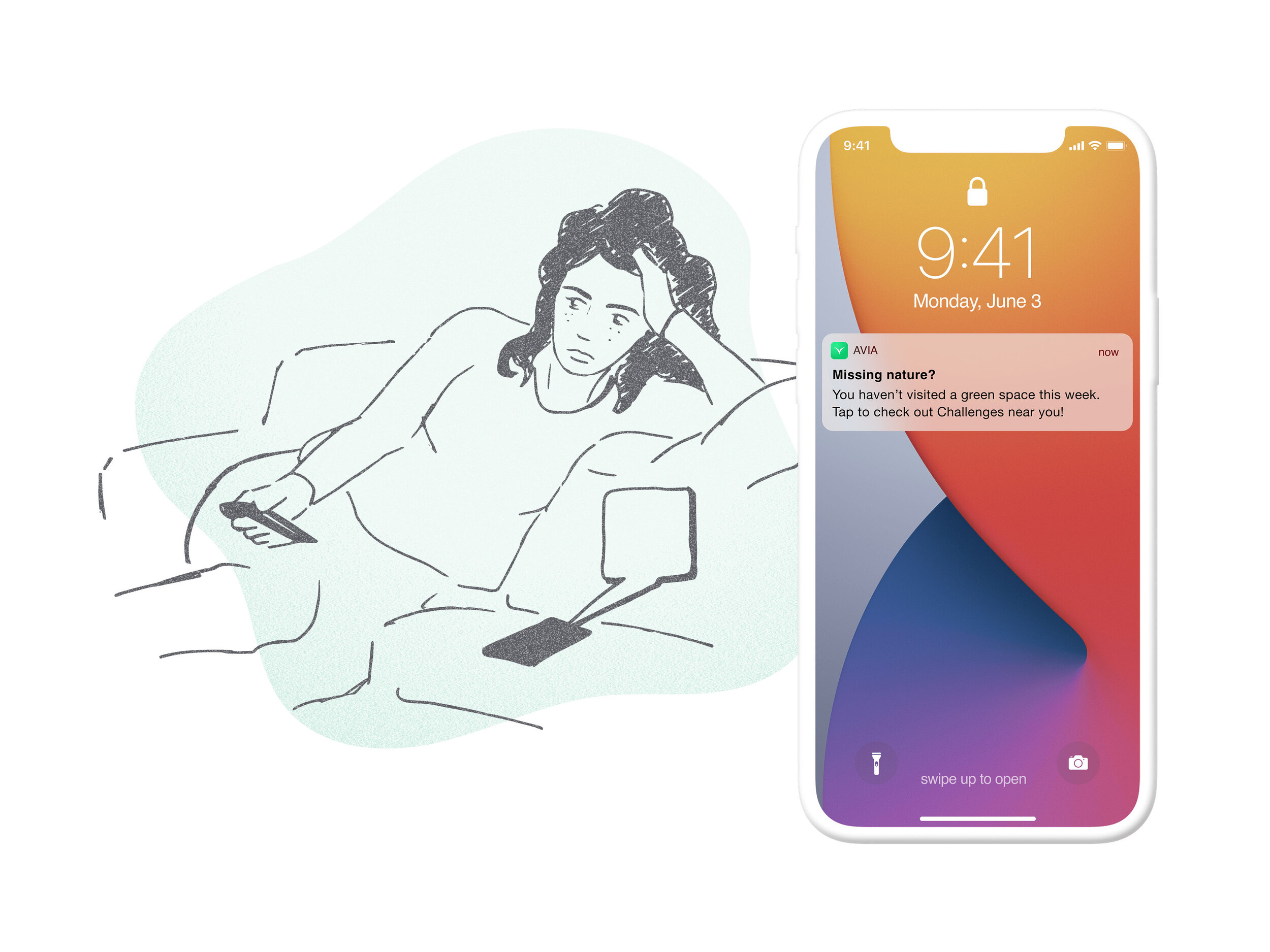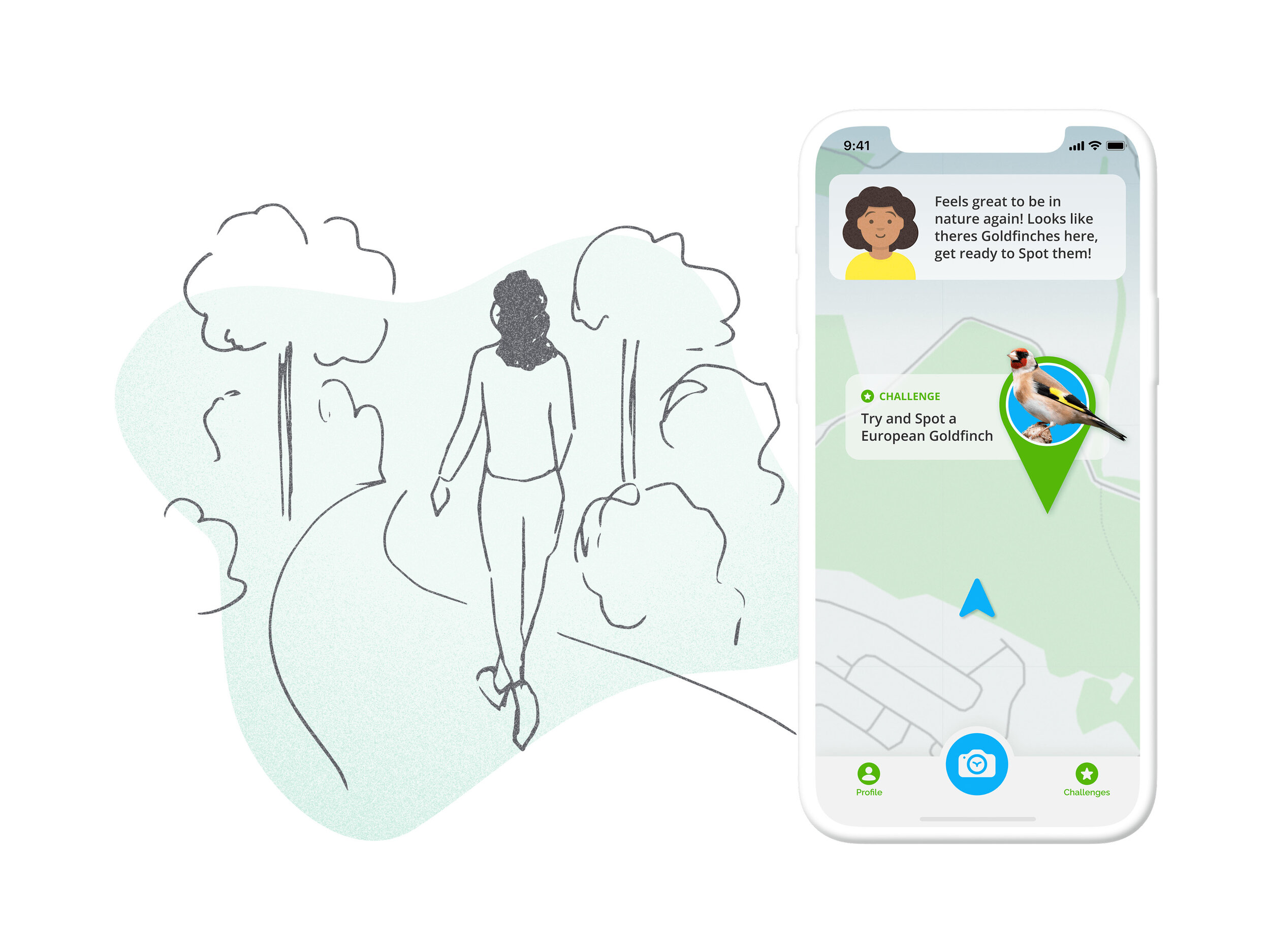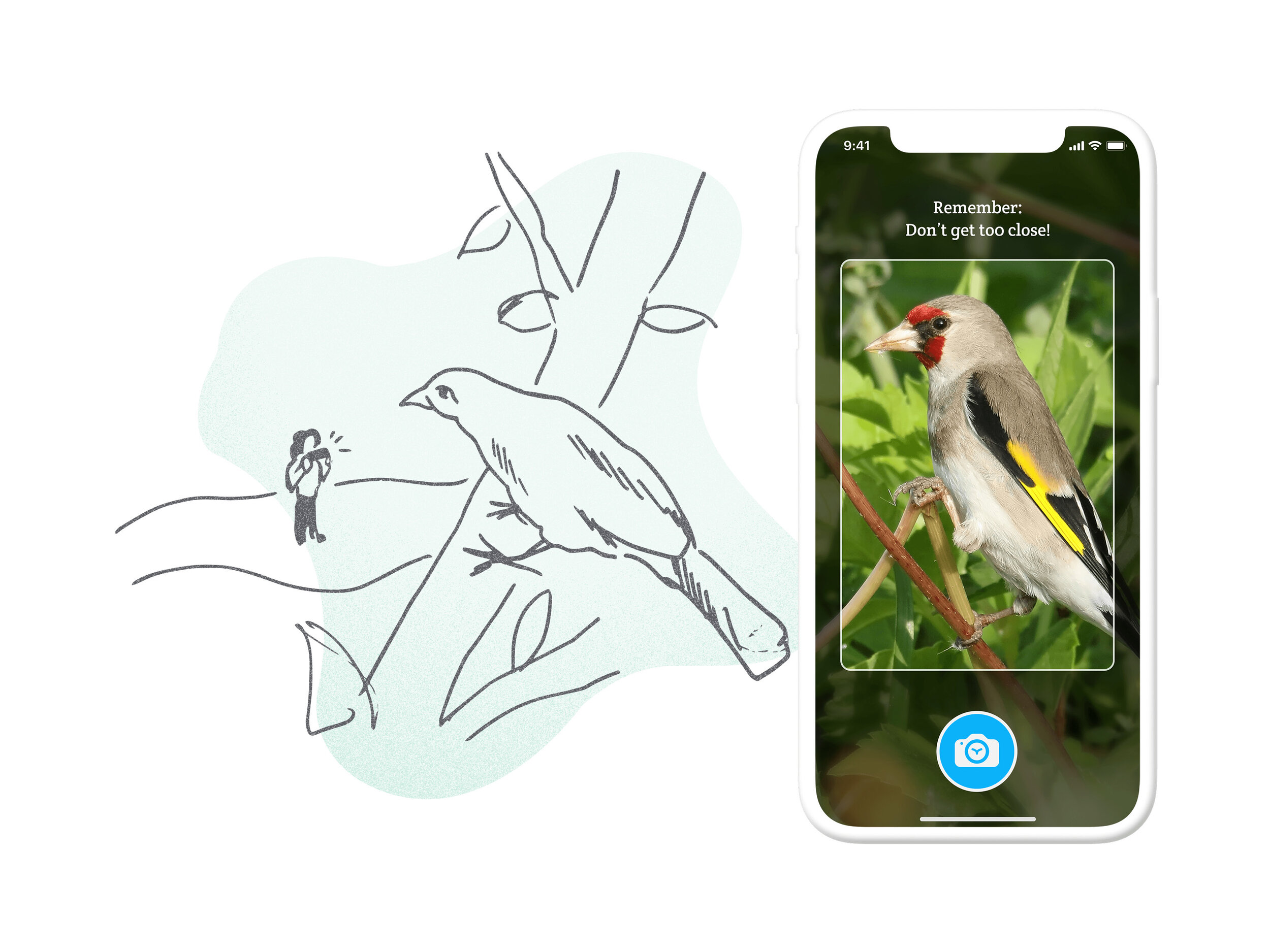Avia
Encouraging users to be more engaged with nature by applying gamification strategies to birdwatching
Overview
Context
Masters project, competition brief set by Hubbub • Duration: 18 weeks • 2020-21
Shortlisted Project
Shortlisted in Hubbub’s Design By Nature competition. View on the Design By Nature website here.
Deliverables
Research report • Low fidelity prototype
Role
Individual masters project support by academic tutor from Loughborough University
The Problem
Spending time and engaging with nature is highly beneficial to physical and mental wellbeing. However our lives have become increasingly urbanised and tech driven with many people losing their connection with nature and not being able to access green spaces.
Process
Discover
Research Phase
The Brief
This research report was initiated in response to a brief set by Hubbub, an environmental communications and campaigning organisation:
Target User
Inspire young people (18-25) living in Manchester, or a city of your choice, to explore and spend time in their local green spaces and engage with the nature on their doorstep in their everyday lives.
Assumptions and
Secondary research
Assumptions were unpacked, using the 5W1H tool. These assumptions were challenged and expanded using secondary research to map out the problem space. Knowledge and desired knowledge were then broken down using the KWHLAQ tool, producing the unanswered questions for primary research to answer.
5W1H tool
KWHLAQ tool
Assumptions and findings after secondary research:
Spending time in nature is beneficial for mental and physical health.
A large proportion of young people suffer from mental health issues to some degree.
Green spaces could be one solution among many to increase mental wellbeing.
More people are living in cities and this makes it harder to access nature for more people.
Without access to biodiversity city dwellers are losing the opportunity to develop an appreciation nature.
There is an indication that young people do value green space and would like more access.
Unanswered questions:
What context do young people visit green spaces?
How do they feel about nature?
How does spending time in nature affect their perceived mental wellbeing?
What are the barriers to engaging with nature?
What are the pain points of spending time in urban green spaces?
How has the COVID-19 pandemic effected their behaviour and attitudes to nature?
Hunt Statement
To guide my research, I initially focused the direction of my project with this Hunt Statement:
I am going to research the existing behaviour, feelings and barriers that 18-25 year olds experience when visiting urban green spaces so that I can design a product or service that encourages higher engagement with nature and contributes to increased mental wellbeing.
Screening Survey
A screening survey was used to source participants for primary research. The survey asked questions about their current attitude towards nature and how often they spent time in green spaces. This was so that a variety of different viewpoints were selected and talked to.
Interviews
Four participants were interviewed remotely due to Covid 19 restrictions. The interviews gave rich qualitative data about young people’s behaviour and attitudes towards nature. Storytelling techniques and sketching were used to encourage participants to share deep descriptive insights.
Reframing
An unexpected finding from one of the interviews was the popularity of birdwatching as a nature based activity and a niche but popular sub-culture. Digging deeper with secondary research unearthed birdwatching further, in particular various youth groups around the hobby. ‘Birders’ were passionate and engaged with nature; demonstrating a lot of the behaviour that the brief set out to encourage.
I decided to pursue this area and see if birdwatching could be a vehicle for encouraging engagement o=among others. I revised my Hunt Statement:
I am going to research the experiences and feelings that non-birders have before and after trying birding for the first time So that I can design a solution that makes this activity more accessible to a wider audience and increases engagement with nature.”
Birdwatching Activity Book
Diary Studies
A limited diary study was designed to capture participants thoughts when carrying out birdwatching for the first time in situ. This took the form of a ‘birdwatching activity book’ sent to four participants with instructions and prompts to share their thoughts as they carried out their birding task.
Define
Synthesis Phase
Data Analysis
Data was analysed using affinity maps to identify themes and findings.
Interview affinity map
Diary Study affinity map
Key Insights
Quotes and findings were synthesised up into rich insights around attitudes towards nature and more specifically young people’s attitudes towards birdwatching. An evaluation matrix was used to identify four key insights:
Young people needed a purposeful activity to be in nature
Despite knowing that spending time in nature improves their mental wellbeing, young people consider this a passive activity and not a valid reason to go. Young people often need a task or activity to give them ‘permission’ to spend time in nature.
Why it matters: By understanding what motivates young people to engage with nature, we can encourage it. This insight suggests that they already know the benefits, however they need an active reason or excuse. We can design an activity that gives them this permission.Young people enjoy photographing wildlife experiences
Young people photographed wildlife highlights and shared on social media. This adds value to the experience beyond the present moment. There is a desirability in sharing these wildlife experiences and gaining validation from social peers.
Why it matters: By capturing the moment in a photo, it becomes more than a moment. It becomes a memory of significance for the user. But it can also act as an advert when shared, promoting the nature activity on social media and snowballing out to followers.Some young people have a negative perception of birdwatching
Young people are deterred by their negative preconceptions of birdwatching however were surprised to enjoy it when they tried it. Misplaced assumptions and stereotypes are closing a potential channel for engaging with nature.
Why it matters: If young people find it enjoyable but are put off by their preconceptions then the opportunity lies in the communication of the activity. Birdwatching could be rebranded, remarketed or repackaged as something else; there is still a potential new channel for engagement with nature.Lacking birdwatching specific knowledge was a barrier to engagement
Young people are unlikely to engage in birdwatching if they do not know where to start or if they do not know about birds. People require help and encouragement when starting a new hobby that has a learning curve.
Why it matters: When someone’s passionate about their hobby they gladly learn as much as they can about it. However, when they’re starting off they have no interest or passion to learn. But if information is fed in a timely way it can act as a spark that initiates a new hobby such as birdwatching.
HMWs
Using these key insights, HMW statements were rapidly generated. These HMWs were then enhanced my adding behavioural change strategies to them. An evaluation matrix was applied to highlight effective HMW statements.
Generating HMWs and applying strategies
Sort HMWs using an evaluation matrix
The remaining HMWs were themed and used to articulate the design opportunity in the form of a UX Vision Statement.
UX Vision Statement
There is an opportunity to design an app using Gamification with elements of Feedback and Behaviour Steering for young people which addresses a lack of purposeful activity in natural spaces whilst improving the user experience by encouraging young people to try birdwatching and wildlife photography
Develop
Ideation Phase
Ideation
Using the UX Vision Statement as a guiding light, Crazy 8’s were used to rapidly ideate different ideas. These ideas were then sorted into categories and shown to target users. The target users then voted on ideas they like; this offered a good idea of what might be popular at an early stage.
This ideation process lead to the concept being a birdwatching smartphone app that uses Gamification to make this hobby accessible and rewarding. Woven into the game would be the importance of GPS location and exploring new areas.
Evaluating Crazy8’s by sorting them into categories
Making
Low fidelity wireframes
The concept was developed by mapping out gamification functions and app features. This was then expressed as low fidelity wireframes that could be viewed in cardboard mock-up devices.
Low fidelity wireframes could be slid through a cardboard phone for quick prototyping
Experience Prototyping
These low fidelity wireframes were tested and iterated, first by bodystorming the scenario myself and later by testing a later iteration with a participant from the target user group. Further testing was limited due to Covid lockdown restrictions.
Deliver
Implementation Phase
UI Design
Despite the scope of this project being limited to a research report, concept and low fidelity prototype, I decided to go further and develop high fidelity UI screens to illustrate the concept effectively.
Outcome
Concept Statement
Avia is for young people living in cities who value engaging with nature but lack the immediate motivation, by providing a gamified experience of birdwatching
Design Principles
Positive, Friendly and Encouraging.
If the user has not visited a green space in the past week, Avia's interface starts to get darker and colours become less psychologically pleasing. This is a subtle behavioural nudge, informing the user that they haven't spent time in nature and offering a clear solution to the dark display.
Challenges involve going to an 'unexplored' green space to reveal the identity of the bird species that is likely to be in that area. Once at the green space, the identity is revealed and the user starts to see if they can 'spot' it. This is a purposeful, nature-based activity.
When the user sees the Challenge bird, they take a photo. Avia uses AI to recognise the species and confirm the spot.
Upon successful image recognition, Avia awards the user with a 'Discovery medal'. Gamification is a great way of offering short term rewards for actions that are good for us but have long-term, hard to realise consequences (such as spending time in nature).
Spending time in nature and completing challenges contribute experience points. Collecting experience points contributes to levelling up.
When the user visits green spaces regularly it remains in a bright, psychologically pleasing colour set. Usage data regarding birding sightings is collected and used to help conservation efforts, giving the game an 'epic meaning'.
Functionality
Inputs
Avia collects geo-location data as well as photo data to tag the locations of bird species.
AI
AI image recognition is used to identify species and confirm successful ‘spots’.
Output
Avia uses this data to deliver functional game mechanics around birdwatching; achievable challenges and point scoring.
Outcome
The game mechanics offer a short-term reward structure around a nature based activity. This can act as an immediate motivation for spending time in green spaces and developing new habits. Over time the user develops a love of nature, clearly feeling the benefits, and no longer needs the short term rewards of gamification as a motivator.
Context Scenario

1/8 Maria is sitting at home watching TV. She’s bored and demotivated. A notification from Avia pops up, informing Maria she hasn’t visited a green space in over a week.

2/8 Maria taps the notification, opening up the Avia app. The home screen’s colours have been dimmed and the avatar looks unhappy. The avatar says “I’m sure it will brighten up once we get back into nature!” Maria naturally wants the interface to return to the bright, emotionally pleasing colours so taps on the avatar's prompt.

3/8 Avia shows a map of nearby green spaces and possible birds that could be there. Some birds are mysteriously silhouetted out - only to be revealed once the user ‘explores’ the new green space. Curious as to what the mystery bird is, Maria walks to the new green space.

4/8 Once Maria arrives at the green space the avatar is excited to be back in green space and the interface reverts back to its bright colours. The identity of mystery bird is revealed and the user is challenged to see if she can ‘Spot’ it.

5/8 Maria walks along looking for the bird. She’s enjoying being in nature again and feels like she has a purpose to be there. Suddenly, she sees a bird and uses Avia to ‘Spot’ it.

6/8 Avia scans the photo and detects the correct bird species. Avia congratulates Maria on completing the challenge, ‘discovering’ the new bird and awards her a medal. Quick facts are displayed about the new bird; this introduces specialist birdwatching knowledge in an accessible way. Maria feels happy and encouraged that she achieved the challenge.

7/8 As Maria walks home and leaves the green space, Avia proclaims her achievements from her ‘exploration’. She unlocked her ‘discovery’ medal, earned three new badges for exploring a new area and spent time in nature. All these achievements earn Maria points that are enough to make her avatar level-up! Her avatar now has some new binoculars and she has a new title. Maria looks forward to showing off her new avatar to her friends on Avia. Maria feels like she has accomplished something and looks forward to getting to the next level.

8/8 Once home, Maria looks at the Avia app. The avatar is happy and the interface is bright after their trip to a green space. The avatar exclaims how her discovery today will help conservationists keep track of birds. Maria feels like she is cooperating in something bigger than herself, happy to play her part in Citizen Science. Avia displays how long Maria has spent in nature; she reflects on the time spent in nature and thinks how much better it makes her feel. She looks forward to spending more time in green spaces and engaging with nature in the future.

Evaluation
Function
Despite this project being a concept app, the functionality can be evaluated as successful so far. The design has been iterated and developed with the test participants using and understanding the product in the expected way.
Behaviour Change
Behavioural change is hard to measure at a small scale, however feedback from testing was encouraging with participants remarking how they hadn’t considered birdwatching until now but could see themselves enjoying it. To really understand whether this app would lead to increased engagement with nature by young people, a wider scale evaluation would be needed, analysing usage data and testing with many participants. A proposed plan for this evaluation is how on the timescale below:
Proposed timescale for a wider scale evaluation.
Ethical Considerations
Ethical consequences would also have to be taken into account. Avia passes its ethical evaluation however there are issues to be aware of in any future development.
As with any app, there are clear dangers in the misuse of collecting of large amounts of user data.
While the desired behaviour change, engaging with nature, can be considered as benign, the user should never be misled or manipulated to this end.
Gamification elements can be addictive and harmful to the user.
Unintended consequences such as bird habitats being disturbed should always be considered.
Conclusion
As a concept Avia offers an innovative and fun way to encourage young people to spend time outdoors and engage with nature. Prototyping and evaluation shows that there is the potential for an effective product here and the possibility for positive behaviour change.
Reflection
I learnt a considerable amount from this project, benefitting from experimenting with new research methods and following my instincts. Research during Covid restrictions is challenging but we have to approach this with a can-do attitude.



















